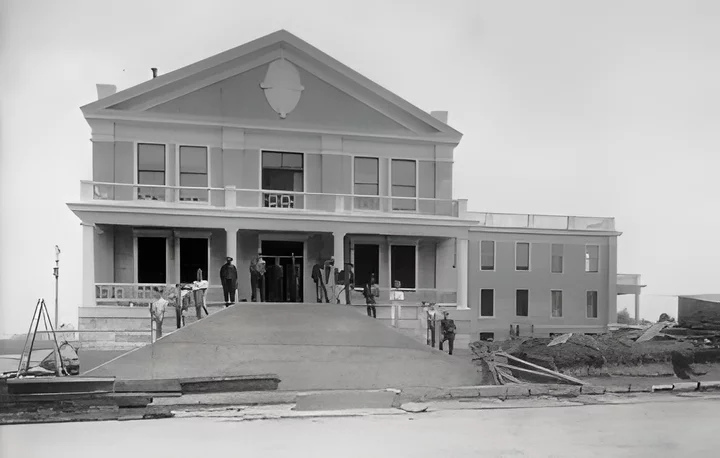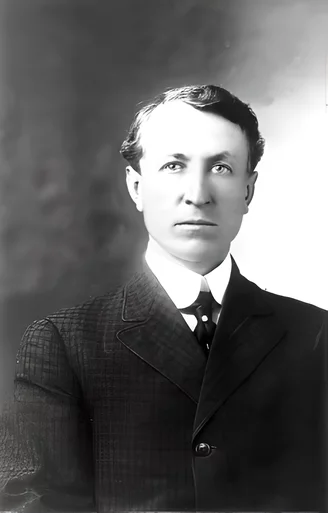Charles C. and Curtis O. Falk established the Northern California Hospital, at the corner of Trinity and F Streets, Eureka, shown here under construction, circa 1906. It later became St. Joseph’s Hospital.
###
ED. NOTE: Suzanne Forsyth, former editor of the Humboldt Historian, was delighted to find herself channeling the pseudonymous voice of “Louella Parsnips” —an ill-reputed, scandal-hungry gossip monger who right-thinking society people publicly abjure — for these pieces of true history.
###
In November of 1911, two respected Eureka physicians, the brothers Charles C. and Curtis O. Falk, got into an explosive argument, leading soon after to a second encounter resulting in the hospitalization of the older brother, Charles C. Falk. This is shocking, but there is more: the initial shouting match between the brothers had broken out in a hospital operating room in the midst of an operation they were performing, as their patient, with his insides exposed, lay anesthetized upon the table. Not even the creators of our modern medical dramas on TV have conjured such a scene, at least to my knowledge, and should they ever do so—should, for example, the Doctors McDreamy and McSteamy of one popular TV series ever get in a fight while performing surgery — remember you saw it first in the Humboldt Historian.
Members of the celebrated Falk family, which locally produced entrepreneurs, doctors, lawyers, and judges over several generations, Charles and Curtis Falk began their professional partnership with high ideals. In 1906, they established the Northern California Hospital, one of the most state of the art facilities in the West. Located at the corner of Trinity and F Streets, the Falk brothers’ hospital incorporated “all the modern ideas and scientific principles, such as ventilation, sanitation, light and heating,” was open to “all reputable physicians” and the general public, and was a registered training school for nurses. Insurance was offered to Humboldt’s laboring men — primarily woodsmen, whose dangerous work brought many calamities — in the form of yearly and semi-yearly certificates.1
Charles C. Falk, the older brother, was the president of the hospital, and his younger brother Curtis was the secretary. In surgery, Charles generally wielded the scalpel, with Curtis attending. Reader, you may now begin to surmise the source of their discord, for it was none other than that oldest and most powerful engine of discontent, jealousy. My informant reports:
It is understood that the ill feelings [had first] cropped out in the form of petty jealousies. It began with Charles getting the credit for difficult operations in which he was assisted by Curtis. It would be said that so-and-so was operated upon by Dr. Charles Falk assisted by Dr. Curtis Falk. Sometimes it would be the reverse. One would win honors which the other deserved, or at any rate was gathering the glory.2
These jealousies may have festered for some time, may even have had their roots in childhood rivalries, but the first outward sign that the brothers’ relationship was not just in trouble, but approaching detonation, was in the operating theater of the brothers’ hospital, and in the presence of several friends and associates of the Falks who had been invited to witness the operation. My informant was among them.
Charles was performing the surgery, with the younger Curtis assisting, and the operation had progressed to the point where Charles was explaining to those present a certain method he had for stitching such cases. Suddenly, Curtis could take no more. In the words of my informant:
Curtis, becoming tired of playing a minor part, then and there took off his rubber gloves and remarked something about being tired of working with such a braggart, inferring that Charles was using the opportunity to win more laurels.3
Bursting with resentment at his brother’s allegations, Charles countered by announcing his intention to sever their partnership, asserting that he would come up with a figure by which Curtis could become the sole proprietor of the hospital.4
All those in attendance were stunned and the Falk blowup immediately became the talk of the town. As to the patient who had lain on the operating table waiting to be stitched up as his doctors squared off, I can offer no report. It seems this fellow was completely forgotten about during his operation, and in the aftermath as well.
The incident was still fueling gossip when Eurekans were treated to yet another scandal, for the flare-up in the operating room was but the prelude to a full-blown knock-down drag-out, which took place two weeks later in Charles’ offices in the Connick and Sinclair building on F Street between Fourth and Fifth. There were no eyewitnesses this time, but several reliable citizens in adjoining offices heard the brothers’ voices and the noise and put the story together. It is said that Charles had now come up with his figure and submitted a proposal to Curtis to purchase the hospital. Curtis declared the figure exorbitant and said Charles named it because he knew it was prohibitive.
My informant gleaned the following account of the altercation from those present in the building:
Language conducive of violence entered into the discussion and soon the brothers were locked in combat. The younger but larger Curtis, who weighs about 185 or 186 pounds, is said to have caught Charles by the throat and brought his free hand around with a mighty blow that sent his older brother, who weighs about 148 or 150 pounds, sprawling on the floor. Charles tried to put up a resistance, the reports say, by making a fight to protect himself in his own office. His resistance was met by other blows and soon the smaller man was completely down and out. He is reported to have asked Curtis if he (Curtis) was going to kill him (Charles), but about that time became unconscious. When he came to his senses again, Dr. E. C. Glatt, a dentist with adjoining offices, was standing at this side, and Curtis was a little distance away in the same room.5
Word got out that Charles was worsted in the fight, his injuries such as to require hospitalization and the constant care of a nurse. My informant, who visited Charles several days after the encounter, reports that he still carried the marks of his brother’s fingers upon his neck.6
Of course, as everyone knows, stories in the streets regarding this incident got a bit out of hand. For example, while it is true that Charles’ pistol was almost within reach, my informant reports that “authentic sources say no attempt was made to use it, and that all reports on the streets about gunplay are unfounded.”7
If the citizenry focused on the Falk feud as the most riveting topic of the day and even let their imaginations run away with them, the Falk brothers themselves were utterly silent on the subject. When pressed by my informant, both men were evasive. Charles said he didn’t want to talk about it, but did acknowledge that he and his brother would have separate offices in the future. Curtis would only state that he was severing his connection with the Northern California Hospital. About the report that the two men had engaged in a physical altercation, both men merely waved it off with a laugh.
As my informant recalls:
Both tried to make light of such reports; both declined to make any statement about what led up to their separation.
In spite of all that had happened between the two men, it does not appear that a lasting separation between the brothers actually occurred, either personally or as business partners in their hospital. Indeed, Curtis was in his brother’s care when he suffered a typhoid infection in the spring of 1918,8 upon recovering from which he joined Charles in the battle against the Spanish influenza epidemic.9 The Northern California Hospital remained open throughout most of 1918 to care for flu patients, closing only when both Charles and Curtis joined the US Army Medical Corps in November of that year.10
After the Army, the Falk brothers each returned to private practice.11 Perhaps they did not want to tempt the gods of ignition by trying the partnership route again. Personally, however, I like to imagine that the brothers did not long deprive the townspeople of some thrilling recrudescence of their rivalry. And so I am putting the pair’s lively misconduct at the top of my list for “Best Medical Melodrama” of early 1900s Eureka.
Before partnering with his brother Charles to build the Northern California Hospital, Curtis O. Falk was a founder of the Sequoia Hospital at 6th & H Streets, Eureka, shown here circa 1908.
###
ACKNOWLEDGEMENTS
Many thanks — and, yes, a time-travel expense account — to my man about town, Rory Hedger.
###
NOTES
- Humboldt Standard, May 10, 1911 (Advertisement).
- Humboldt Standard, Friday December 29, 1911.
- Ibid.
- Ibid.
- Ibid.
- Ibid.
- Ibid.
- Humboldt Times, April 6, 1918.
- Humboldt Times, November 16, 1918.
- Humboldt Times, November 8, 1916.
- The Falk brothers sold their hospital in 1920 to the Sisters of St. Joseph of Orange, who renamed it St. Joseph Hospital, which continues to this day.
###
The story above was originally printed in the Spring 2012 issue of the Humboldt Historian, a journal of the Humboldt County Historical Society. It is reprinted here with permission. The Humboldt County Historical Society is a nonprofit organization devoted to archiving, preserving and sharing Humboldt County’s rich history. You can become a member and receive a year’s worth of new issues of The Humboldt Historian at this link.



CLICK TO MANAGE